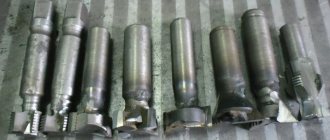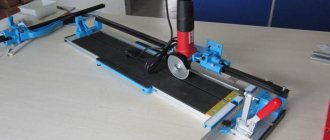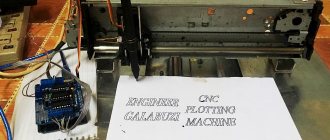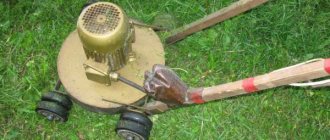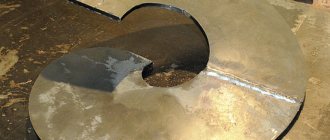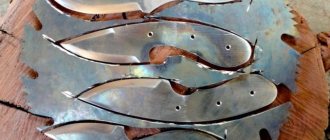Do you want to try soldering aluminum at home?
, but are tormented by doubts that nothing will work out?
Don’t worry - we’ll tell you what to do and how to do it, and most importantly, what to solder with
so that everything works out! All recommendations have been tested in practice and proven to be effective.
What do you need to solder aluminum?
? One of the main tools is a heating device.
It can be like an electric soldering iron
with a homemade nozzle (we’ll tell you how to make it below), and a more advanced option -
a gas
can with
a burner
.
In this case, you will need a cylinder with a mixture of two (propane/butane) or three gases
(propane, butane, isobutane).
Please note that soldering and welding of aluminum
- this is not the same thing at all.
Although many people often confuse these concepts. Let's bring some clarity to what aluminum soldering and what welding is.
Welding means joining metal by heating it, then melting it and mixing it in a weld pool. Typically, argon welding and special filler rods
.
Some home craftsmen even remake ordinary welding
inverters for argon welding.
As a result of welding aluminum, a very strong and monolithic connection with the same crystal lattice is obtained. Quality of welded
details are quite high.
Under the term " soldering aluminum"
the aluminum
together . In this case, the metal itself does not heat up to the melting point.
The peculiarity of soldering is that you can solder an aluminum pan
or another container (if there is a crack in it), and you can also
solder
aluminum to another metal.
But welding
two different metals is difficult.
There are different methods for soldering aluminum
and
duralumin
. We will look at some of the most popular and effective methods that are applicable in everyday life.
How to tin aluminum
The procedure for soldering aluminum elements at home is a very problematic process, which is facilitated by the use of special materials.
The work is complicated by the immediate appearance of a thin oxide film at the stripping site, which interferes with soldering. An additional difficulty is created by the material itself, which has a low melting point (+660 °C).
Using solder for soldering aluminum, special strong fluxes and following technology, you can independently solder almost any aluminum object.
Features and principles of soldering
The low temperature value of metal melting complicates the technological process of soldering, as well as repairing products with your own hands.
Parts very quickly lose strength when heated, and structures reduce stability when the temperature reaches 300 degrees.
Low-melting solders consisting of bismuth, cadmium, indium, and tin come into difficult contact with aluminum and do not provide sufficient strength. Excellent solubility is observed in the metal in combination with zinc, which makes the soldered areas highly reliable.
Before soldering begins, aluminum elements are well cleaned of oxides and dirt. To do this, you can use mechanical force with brushes or use special fluxes made from a potent composition. Before the procedure itself, be sure to tin the areas to be treated.
The tin coating will protect the part from the formation of oxides. In order to reliably solder aluminum products, it is necessary to choose the right heating tool, taking into account the volume of metal being processed.
In addition, the reliability of the connection depends on the alloy chosen, as well as the flux for soldering aluminum.
Soldering methods
Soldering of aluminum products is carried out with an electric soldering iron, a blowtorch or a gas torch. There are three ways to solder various aluminum objects:
- with rosin;
- using solders;
- electrochemical method.
With rosin
This option for soldering aluminum objects, wires, cables is used for small parts.
To do this, the cleaned section of the electrical wire is covered with rosin and placed on a piece of sandpaper with a medium grain size. The wire is pressed from above with the tinned tip of a heated soldering iron.
This action is carried out several times, after which the procedure of soldering the electrical wires itself is performed. You can use a rosin solution in diethyl ether.
In this case, the end of the soldering iron is not removed from the end being tinned, but rosin is added on top. An electric soldering iron with a power of about 50 W is suitable for twisting thin aluminum wires. With an aluminum thickness of about 1 mm, a 100 W soldering iron is required, and parts larger than 2 mm require preheating of the joint.
Using solders
This method is the most common and is used in electrical engineering, in the repair of automobile parts, as well as other products. Before soldering aluminum, the area to be soldered is pre-coated with an alloy and the tin-plated elements are subsequently connected. Pre-tinned parts are connected to each other, as well as to other alloys and metals.
Soldering of elements can be carried out using light alloy solders containing tin, zinc, and cadmium. In addition, refractory materials based on aluminum are actively used.
Why are light alloy compounds used? Because they allow you to solder an aluminum product at temperatures up to 400 degrees. This does not produce qualitative changes in the properties of the metal and maintains its strength.
Compositions with cadmium and tin do not create sufficient contact reliability and are susceptible to corrosive effects. Refractory materials containing zinc, copper, and aluminum-based silicon do not have these disadvantages.
Electrochemical method
This procedure requires a plating facility. With its help, copper plating is carried out on the surface of a product or wire. In its absence, independent processing of the part is used.
To do this, apply a few drops of a saturated solution of copper sulfate to the area cleaned with sandpaper.
After this, the negative pole of an independent power supply is connected to the workpiece.
They can be a battery, an accumulator, or any electrical rectifier.
A cleaned copper wire with a diameter of about 1 mm, located in an insulated stand, is connected to the positive terminal.
During the electrolysis process, copper will gradually deposit on the part, after which the area is tinning and dried using an electric soldering iron. After this, you can easily solder the tinned area.
Solders, materials, fluxes
Soldering of aluminum with tin is carried out subject to the use of highly active fluxes, as well as good cleaning of parts of the parts. Such tin compounds require additional coating with special compounds, since they have low strength and poor protection against corrosion processes.
How to solder aluminum elements? High-quality solder joints are obtained by using solders with silicon, aluminum, zinc, and copper. These materials are produced by both domestic and many foreign manufacturers.
Domestic brands of rods are represented by the most used solders TsOP40, which according to GOST contain 60% tin and 40% zinc, as well as 34A (aluminum - 66%, silicon - 6%, copper - 28%). The zinc used gives high strength to the contact area and provides good corrosion resistance.
Imported low-temperature alloys with excellent characteristics include HTS-2000, which provides maximum ease of use.
These alloys are used to work with large-sized parts (radiators, pipes) with high heat dissipation using a heating pad or objects made of aluminum alloys that have a fairly high melting temperature. Novice repairmen can familiarize themselves with the soldering process by watching an instructional video. This will help to avoid many unpleasant nuances during the work process.
In addition to solders, aluminum soldering requires the use of special fluxes containing ammonium fluoroborate, zinc fluoroborate, as well as triethanolamine and other elements.
The most popular is the domestic F64, which has increased chemical activity. It can be used even without first removing the oxide film from products.
In addition to it, 34A is used, containing lithium, potassium and zinc chlorides, as well as sodium fluoride.
Preparation of products
Reliability, as well as excellent quality of connections, is ensured not only by using the right technology, but also by preparatory work. These include the treatment of sealed surfaces. It is necessary to remove contaminants and thin oxide films.
Mechanical processing is carried out using sandpaper, a metal brush, stainless steel wire mesh or a grinding machine. In addition, various acid solutions are used for cleaning.
Surface degreasing is carried out using solvents, as well as gasoline or acetone. On the cleaned aluminum area, an oxide film appears almost immediately, but its thickness is significantly lower than the original one, which facilitates the soldering process.
Heating tools
How to solder aluminum at home? Electric soldering irons are used to solder small-sized aluminum products at home. They are a universal tool, quite convenient for soldering wires, repairing small tubes and other elements.
They require a minimum of working space, as well as the presence of an electrical network. Repair of large-sized products and welding are performed with a gas torch that uses argon, butane, and propane.
When using gas burners, it is necessary to constantly monitor their flame, which characterizes a balanced supply of oxygen and gases. With the correct gas mixture, the fiery tongue has a bright blue color. A dim hue, as well as a small flame, indicate an excess of oxygen.
Technological process
The technology for soldering aluminum objects is similar to the process of joining parts of other metal materials. The first step is to clean and degrease the areas of future adhesion. Then the connected elements are installed in working position for ease of processing.
Flux is applied to the prepared area, and the initially cold product begins to heat up using an electric soldering iron or a torch. As the temperature rises, the solder bar begins to melt, which must constantly touch the surface of the elements, controlling the heating process.
Soldering aluminum elements at home with an electric soldering iron is done in a well-ventilated room, as hazardous compounds are released during operation.
Using flux-free solder requires compliance with some nuances. To prevent the oxide film from interfering with the alloy getting onto the parts, the end of the rod makes scratching movements along the area where the elements are soldered. This breaks the oxide integrity and the solder comes into contact with the metal being processed.
Destruction of the oxide layer during soldering can be done using another method. To do this, the area to be treated is scratched with a metal brush or a stainless steel rod.
To ensure maximum strength of aluminum parts in the soldered area, the treated areas are pre-tinned. Compliance with the technology of soldering aluminum elements guarantees excellent quality of the connection, as well as its protection against corrosion.
Flux
When choosing a flux, it is necessary to take into account that not all of them can be active towards aluminum. We can recommend using products from a domestic manufacturer for such purposes - F-59A, F-61A, F-64, they consist of ammonium fluoroborates with the addition of triethanolamine. As a rule, the bottle is marked “for aluminum” or “for aluminum soldering.”
Domestic flux
For high-temperature soldering, you should purchase flux produced under the brand 34A. It consists of potassium chloride (50%), lithium chloride (32%), sodium fluoride (10%) and zinc chloride (8%). This composition is most optimal if high-temperature soldering is performed.
Recommended flux for packing at high temperatures
How to solder aluminum with tin?
Soldering aluminum with standard solder using conventional technology is unreliable and impossible. The tin on it rolls into a ball, not wanting to stick, and if it does stick, the result is a weak connection that breaks under the slightest load. To prevent this from happening, you need to solder in a special way, and then even ordinary solder will hold tight.
Browse products for inventors. Link to the store.
- solder 60/40;
- mineral oil or petroleum jelly;
- alcohol.
How to solder aluminum correctly
An oxide film instantly forms on the surface of the aluminum, which prevents adhesion between the base and the solder. To prevent it from interfering, you need to create an airless environment at the soldering site. To do this, apply a thin layer of Vaseline to the area of aluminum that has been cleaned of dirt. You can use mineral or other automotive oil instead.
DIY electronics in a Chinese store.
If Vaseline was used, then you need to apply a soldering iron tip to it so that it melts into liquid oil. After this, take a mounting knife or other sharp object and use it to scratch the aluminum under the Vaseline.
It is important that the scratches are made on a surface that is sealed from air. As soon as the Vaseline begins to thicken, it should be melted again with a soldering iron tip.
You need to actively rub with a knife blade to remove the oxide film on the metal, and in addition to create a relief to which the solder will then stick well.
After removing the oxide film, the oil is not erased. A soldering iron tip is applied to the soldering site, and the aluminum is heated to operating temperature. Then the required amount of solder is deposited. It will sit right in the oil.
A drop of solder is lightly rubbed over the prepared surface. You need to press it into the resulting scratches. The solder will push the oil to the sides so it won't interfere with adhesion. The absence of an oxide film will allow the tin to stick to the aluminum, rather than forming into a ball that easily falls off.
Then, tinned wires, wire, or whatever is needed can be applied to the surface prepared with oil and friction. They will be soldered in a second, without taking all the tin from the aluminum, as usually happens. After soldering, the remaining oil is removed with a cotton swab soaked in alcohol.
This method allows you to achieve the same soldering reliability as when connecting two copper elements. Moreover, unlike another common method with oil, when the oxide film is removed by five minutes of friction with a hot soldering iron tip, tearing it off with a knife is faster.
How to solder aluminum correctly
Sometimes a situation arises when it is not possible to replace old aluminum wiring and you simply need to make a high-quality connection between aluminum and copper. For this, of course, you can use specialized connectors, crimps or terminal blocks, but I want to tell you how you can reliably and efficiently solder copper and aluminum.
What is the difficulty of soldering?
As you know, aluminum is a very active metal and when interacting with atmospheric air, it is almost instantly covered with an oxide film, which rejects the solder and does not allow aluminum to be simply tinned.
In order for the solder to “stick” well to the metal, you need to remove the existing film and prevent it from forming again until you apply the solder.
Special fluxes were invented specifically for these purposes: they actively use soldering acid, and use a mixture of rosin and acetone.
Preparing inventory
In order to successfully complete this work you will need: a soldering iron with a power of at least 60 W, a knife, pliers, sandpaper or a file, POS 61 or POS 50 solder, F-64 flux or its equivalent, a brush, a sponge and rags.
We solder aluminum with tin and F-64 flux
Important. Soldering of conductive elements using F-64 and any of its analogues is prohibited according to the rules of the PUE. Since the use of acid causes not only the destruction of the oxide film, but also actively destroys the metal itself, and after tinning, this acid cannot be removed and it continues destructive processes under the solder.
In this way you can, for example, solder an aluminum decorative part.
The algorithm for working with F-64 flux itself is very simple. First, we strip the insulation on the aluminum core, then use sandpaper or a knife to process the core itself in order to remove a thick layer of film.
Then we apply flux to the stripped core with a brush and clean it again under flux. Thus, the flux prevents the formation of a new film.
Then, using a well-heated soldering iron, we begin to apply tin to the prepared core. At the same time, you use a soldering iron to rub in solder.
Once you have tinned one track, apply flux again and repeat the procedure. This way you can completely cover the core with solder and then solder it to the place or part you need.
After you have completely processed the veins, you must rinse it in a soda solution (five tablespoons of soda per 200 grams of water). This is necessary to wash away the remaining active substances, which are part of F-64.
Soldering aluminum to copper using tin and rosin
In order to solder the conductive cores of copper and aluminum wires, you cannot use acid fluxes, but you need to use liquid rosin, which will also ensure a reliable connection.
This rosin can be purchased ready-made, or you can prepare it yourself; for this you will need lump rosin (it is crushed into powder) and pure alcohol.
Then we mix these two components in the following proportion: 60% rosin and 40% alcohol. Then put the bottle in warm water, wait until it warms up and mix thoroughly until the rosin is completely dissolved.
That's it, the solution is ready and you can use it.
Also, in addition to all the above equipment, we still need to prepare a small container into which we will immerse the stripped end of the wire.
We also remove the insulation and clean the core from a thick layer of foam, then immerse our bare end of the wire so that it is completely in liquid rosin and use a knife to process the core again.
Next, we take a preheated soldering iron and begin to process the core at the very surface of the rosin, rotating it and removing it as the wire is tinned.
The trick is to tin the aluminum right at the border between the rosin and the air so that the air does not oxidize it.
Make sure that the soldering iron does not lose temperature and, if necessary, remove it from the bath so that it warms up well.
Important. This work produces a lot of smoke, so it is better to do it outdoors or in a room with excellent forced ventilation.
After you have tinned the aluminum, the residual trace of rosin can be easily removed with a rag soaked in alcohol. You can then twist the tinned aluminum and copper wires into a classic twist and immediately solder it.
Tin will serve as an excellent neutralizer of the galvanic interaction of copper and tin and guarantees that such a connection will last a very long time and trouble-free.
Perhaps the only and significant drawback of such a connection of copper and aluminum is the fact that soldering in a distribution box located under the ceiling and in the absence of the proper supply is almost impossible.
In this case, it is better to use other methods of connecting the wires in the junction box.
That's all I wanted to tell you about soldering aluminum using special solders and regular tin with rosin. I hope you find this article useful and interesting. Thank you for your attention.
Source
Required materials and tools
For tinning, first of all you will need a soldering iron. For work, take a device with a power of about 60 W. Soldering is carried out in a well-ventilated area: when the flux is heated, toxic fumes are formed. It is advisable to equip the workplace with a hood. In addition, you should prepare the following:
- Flux, soldering acid or rosin. The latter is diluted with alcohol in a ratio of 3:2.
- Sharp knife.
- Pliers, side cutters.
- Fine grit sandpaper.
- Electrical tape or heat shrink tubing.
How to tin aluminum?
The highest quality aluminum welding is argon arc welding. However, this method requires both expensive equipment and highly qualified welders, which often does not always correspond to reality.
In addition, the equipment for this welding method is quite cumbersome and in some places its use is generally prohibited. In this article we will talk about alternative and inexpensive methods for welding aluminum without the use of argon.
Method 1: using Zeller 480 aluminum electrode
The Zeller 480 repair electrode with 12% silicon content is designed for welding a wide range of aluminum alloys including silumin and duralumin. This method allows you to reliably weld aluminum without the use of expensive argon arc equipment.
Benefits and Applications
- If the welding process is followed, the quality of the weld made using the Zeller 480 electrode is not inferior to argon arc welding;
- High surfacing productivity;
- Dense deposited metal without pores;
- Thanks to the soft, uniform arc, the seam is even and smooth;
- Zeller 480 is the only aluminum electrode available in a “low temperature” 2mm size;
- The electrode is equipped with a special protective coating, which is highly moisture resistant, which significantly extends the service life of the electrode;
- Welding is carried out without flux, since all the necessary elements for removing the oxide film are contained in the protective coating of the electrode;
- Used for welding aluminum sheets, profiles, busbars, tanks, aluminum castings, eliminating casting defects, crankcases, car bodies, etc.
Important! Since the coating of aluminum electrodes contains hygroscopic salts, after completing all welding work, the packaging should be hermetically sealed and stored in a dry, warm place.
Instructions for use
Step 1. Before starting welding, make sure that the prepared metal sample is dry, since aluminum is hygroscopic (absorbs moisture). Using a stainless brush, clean the joints to a metallic shine and remove any remaining dirt in the area around the seam.
Step 2. If necessary, dry the electrodes for 1-1.5 hours at 100°C.
Step 3. Heat the aluminum sample to a temperature of 150-200°C using a burner.
Important! Welding cannot be carried out without heating!
Step 4. Welding is carried out using direct current of reverse polarity. The most vertical position of the electrode while maintaining a short arc. The electrode should be fed into the fusion zone quickly, moving forward as much as possible and maintaining a very short arc.
Step 5: Weld one layer in one pass.
Be careful! The welding speed is the same as that of semi-automatic welding.
The tensile strength of the weld is 200 newtons per square millimeter, which is close to the tensile strength of the base metal. Therefore, this welding method can be used on critical structures.
Method 2: Using HTS-2000 or Castolin 192 solder
HTS-2000 or Castolin 192 solder is an alloy in the form of a zinc tube filled with solid flux powder in the center, which makes welding quick and easy.
The solder is made using high technology and is specially designed to carry out work on the restoration of parts made of aluminum.
At the same time, welding does not involve the use of high-cost technologies.
All you need to repair aluminum parts is just the solder itself and a gas torch for welding.
General recommendations for achieving the best results when working with solder
- Clean the work surface immediately before applying solder.
- You should not melt the solder in a torch flame, as this will prevent it from bonding to the metal.
The solder must melt on its own on the surface of the part! - In the liquid state, solder is quite fluid, so it is worth tinning the surface well to eliminate the presence of cracks, especially at the soldering site.
- Also make sure that the forming elements fit tightly together.
- When applying solder, wait until it absorbs.
Otherwise, sufficient adhesion of the metals will not occur, and, as a result, the required strength of the product will not be achieved.
How to solder aluminum with a soldering iron at home?
Aluminum is a metal that is difficult to solder. This is due to its tendency to form a strong oxide film on the surface of products, which prevents the part from being wetted by molten solder.
Mechanical cleaning of the surface alone does not help, since new oxide is formed instantly after removing the old one. For this reason, special fluxes are used for soldering aluminum and special technology is followed.
Connecting wires
Typically, aluminum soldering is used in cases where the parts to be joined are small enough and the use of argon welding is impossible or absent. One example of the use of soldering is connecting electrical wires made of different materials.
Often in practice it is necessary to connect copper and aluminum wires. Such connections cannot be made by twisting, since this pair of metals forms a source of electrochemical corrosion . In this case, soldering aluminum to copper can be an excellent connection option.
This operation can be performed with ordinary soft lead-tin solder, but you should use a special flux for soldering aluminum. The procedure must be performed in the following sequence:
- first you need to strip the copper wire and tin it using rosin;
- to tinning an aluminum wire, after mechanical stripping of the oxide film, it should be coated with a layer of flux for soldering aluminum;
- for better mechanical strength of the connection, tinned wires can be twisted;
- By heating the joint with a soldering iron and adding flux, the solder melts and a solder is formed.
The connection obtained in this way can be safely embedded in the wall; it will last for a very long time.
Removing the oxide film
Usually, if you have a good flux specifically designed for soldering aluminum, the use of any special tricks is not required; it is enough to mechanically clean it and moisten the surface to be soldered with flux.
It is also possible to use acid for soldering aluminum. They use hydrochloric acid in which zinc is dissolved (soldering acid), and fluxes based on orthophosphoric acid are also used.
But if such a flux is not available or, due to poor quality, does not provide soldering, you can go another way. There are several ways to remove the oxide film for successful tinning of the workpiece.
What is necessary?
Working tools and material for the future design - this is what needs to be prepared before creating the device itself.
- Handle material. There are no strict criteria for its selection, so everything depends on the ingenuity and capabilities of the manufacturer. The handle should be comfortable and not warm up during operation. It is most reasonable to take a ready-made handle - a handle from a broken boiler or soldering station will do.
- Conducting tube. It must be steel, so the manufacturer chooses a steel tube with a diameter of no more than 1 cm and a wall thickness of 2.5 cm.
- Burner body. And it must be steel, and the divider is made of a brass rod.
- Nozzle. It is made from a metal rod.
Tools you will need: grinder, semi-automatic welding machine, file, drill press or drill, tap, drill bit, blade, hammer, pliers, stripping and cutting wheels, metal brush, protective equipment. You don't always need everything from the list, but it is included in the standard set.
Tinning aluminum with tin – Metals, equipment, instructions
Aluminum is a metal that is difficult to solder. This is due to its tendency to form a strong oxide film on the surface of products, which prevents the part from being wetted by molten solder.
Mechanical cleaning of the surface alone does not help, since new oxide is formed instantly after removing the old one. For this reason, special fluxes are used for soldering aluminum and special technology is followed.
In rosin
An aluminum wire or other part can be freed from the oxide film by immersing it in liquid rosin. To do this, you can either melt it or prepare an alcohol solution.
After immersing the part in rosin, use a sharp knife to scrape off the oxide film. The rosin layer prevents the access of air and the formation of new oxide. After this, the part can be tinned using a heated soldering iron with solder.
Abrasive powder
In the absence of flux and rosin, aluminum soldering can be done as follows. A paste is prepared consisting of abrasive powder and transformer oil.
Fine metal filings can also be used as an abrasive. The workpiece is coated with this composition, after which it is rubbed with a hot soldering iron with solder.
As a result of this, the abrasive grains or metal shavings remove the film, and the surface is immediately wetted with solder without access to air. After tinning, the product can be easily soldered.
Chemical cleaning method
In essence, this method is nothing more than copper plating of an aluminum surface. It is performed as follows.
That part of the aluminum billet that is to be coated with a layer of copper is moistened with a solution of copper sulfate. Then take a direct current source with a voltage of 4.5 volts.
This could be a battery or accumulator. The aluminum part is connected to the negative terminal of the power source. A copper wire is connected to the positive terminal, the end of which is entangled in the bristles of a toothbrush.
Next, the brush is moistened with a solution of copper sulfate. The wire located in the bristles must be well moistened. After this, rub the area of the part previously moistened with the solution with a brush.
As a result of the galvanic reaction, the surface of the aluminum is coated with a thin layer of copper, allowing it to be soldered as if it were a copper part.
Warming up the part
When soldering fairly massive parts, the power of a conventional electric soldering iron may not be enough to heat the workpiece to the required temperature.
You can use a gas burner to heat aluminum at home. For this purpose, it is better to use a portable burner powered by a small gas cartridge. In this case, you need to work very carefully. It is unacceptable to overheat the base metal to the point where it begins to melt.
You can also use a combined heating method. For example, place a massive aluminum piece on the burner of a kitchen gas stove and light a small fire. You can use an electric soldering iron at the soldering site.
Everything that has been said about methods for soldering aluminum applies to various alloys based on this metal. Only the topic of silumin soldering is somewhat isolated. This material is an aluminum alloy containing silicon (roughly speaking, sand).
Soldering this alloy presents particular difficulties. Attempts to solder silumin often fail.
Even after seemingly successful soldering, it turns out that the connection does not have the required strength and may break. Experts do not recommend soldering this material. The best way to join this alloy is argon arc welding.
High temperature process
Industrial methods of aluminum soldering are distinguished by the use of harder solders containing aluminum. To use this technology, factory equipment and special fluxes are required.
Thus, heating and soldering of workpieces is carried out in special tunnel-type furnaces. The soldering process is carried out in an environment of inert gases at temperatures reaching 600 ℃. This technology is used in the manufacture of aluminum radiators and heat exchangers of modern cars.
How to solder aluminum at home with a soldering iron
| Aluminum is highly durable and a good conductor of heat and electricity. It has a low specific gravity, is easy to process, and is environmentally friendly. However, all these positive qualities create almost insurmountable obstacles when solving the problem of how to solder aluminum at home with a soldering iron. This cannot be done using traditional methods, so you have to use special welding methods and optimally selected materials. Technical difficulties in soldering aluminum products and partsSoldering aluminum structures and other elements is always quite difficult, especially if it is done at home by novice craftsmen who have not fully studied the process. Basically, such soldering is performed industrially using special equipment. However, it is quite possible to create the most suitable conditions for welding parts made of aluminum. To achieve this goal, it is necessary to resolve several technical problems:
Preparation for soldering aluminum partsGreat importance is attached to preparing aluminum for upcoming soldering. There are several ways to do this to ensure connection reliability:
|
Advantages
- Soldering aluminum with tin is relatively inexpensive, since the cost of solder is low;
- The material is universal and suitable for working with both thick and thin workpieces;
- Solder melts well when exposed to temperature and spreads well over the surface, forming a high-quality connection, penetrating into all small cracks and recesses;
- Due to the low melting point, the process is relatively fast;
- The material is always available for sale and there are no problems with its search and selection.
Process Features
The surface of aluminum parts is covered with an oxide film, which has high chemical resistance, as well as a melting point 2 times higher than pure metal. In the range from +2500С to +3000С aluminum becomes unstable and melts. The minimum melting temperature of the oxide film is +5000C.
When soldering, the parts being connected under the outer layer begin to melt. Therefore, the shareholder needs to eliminate the negative impact of the oxide layer. The principle of all methods is based on film removal, as well as increasing adhesive properties.
Methods for removing the oxide layer:
- mechanical - the use of abrasive tools for stripping;
- chemical - the use of fluxes with special compositions;
- electrochemical - based on electrolysis processes.
Both methods are carried out only in an environment without oxygen.
Application of technology
When tinning, tin or alloys based on it are used.
Tin coating is used for:
- application to brass parts that are subject to soldering;
- protection of surfaces of steel products during nitriding;
- separating metal products by applying a layer of tin when mating copper surfaces with steel or aluminum in order to equalize the electrode potentials;
- To protect against the effects of sulfur contained in the rubber insulating layer, it is necessary to tin the cable;
- applying a corrosion-resistant coating to tin, which is used for the manufacture of canning containers;
- protection of various metal products from rust.
Tin-lead coating (PLC) is used in the following cases:
- preparing radio components for soldering and protecting them from corrosion;
- Tinning wires to improve solderability.
The recommended thickness of the poluda layer is given in the table.
| Purpose | Thickness, microns |
| Protection of steel parts: | |
| from corrosion | 21-24 |
| during nitriding | 9-12 |
| when gumming | 12-15 |
| Improved solderability: | |
| spring parts | 3-9 |
| steel parts | 6-15 |
| parts made of copper and copper alloys | 3-9 |
| parts made of aluminum and its alloys | 6-15 |
